Before World War 2 France bred some of the great classic sports and luxury cars: vehicles made by
Bugatti,
De!age,
Delahaye,
Hispano-Suiza and
Hotchkiss were spoken of in the same breath as
Rolls-Royce and
Mercedes-Benz. However, when the debris of war was cleared away in 1945, several of the great names never reappeared, and those that did lasted only a few years before withering away.
There were two main reasons for this: the French economy left few people wealthy enough to buy expensive sports and luxury cars; but mostly it was the French car taxation system which killed off the makers of luxury cars. The government imposed a punitive tax on cars over 15 hp which ranged up to nearly a tenth of the price of a luxury car - and this was not a oncer - but a tax payable each and every year you owned it!
The tax virtually killed off all French cars with engines over 2.8 litres. Although several makers attempted to build special cars with engines below this limit, they were unsuccessful, largely because of the low specific output of most non-racing engines, which meant that few cars could aspire to real high performance or carry a large luxury body.
Jean Daninos
It seemed that France was destined to become a producer of micro economy cars for the masses, but Jean Daninos had other ideas. Daninos was the owner of Facel Metallon, a company which he had formed before the war to carry out general engineering work. The company was involved in making parts for the aircraft industry, building office furniture and a variety of other sub-contract work.
Daninos entered the motor industry when several French manufacturers who required bodies for specialised cars came to Facel for this work to be done. Facel built bodies for the Dyna Panhard, the Simca Sport coupe and the Ford Comete and, in so doing, gained a good deal of expertise both in body building and design, as the company assisted with design work on some of the bodies.
The Simca Plein Ciel
Although Facel continued to build Simca bodies into the 1960s, they lost the Panhard contract when Panhard decided to build their own bodies, and Daninos decided to go into car manufacturing himself. The company had already built special bodies on Bentley chassis and had a great deal of influence on the design of Simcas like the Plein Ciel, so it was not a great step for Facel to take. Their first effort was a four-door saloon which owed a good deal to Simca styling although it used mostly Ford components. However, it was too much like other cars already in production and Daninos decided to go for the luxury market.
The car which was unveiled at the 1954 Paris Motor Show set the motoring world talking; not only was it the first luxury car of any consequence to emerge from France since the war, but it was as good as contemporary foreign cars. Although the body shape was reminiscent of the Simca coupes which Facel were building, the nose treatment was novel. The
radiator incorporated a vertical section flanked by two small horizontal grilles, with the lights set into separate housings in the front wings. This Facel trademark was to remain with the marque, albeit in modified form, for the rest of its ten-year life span.
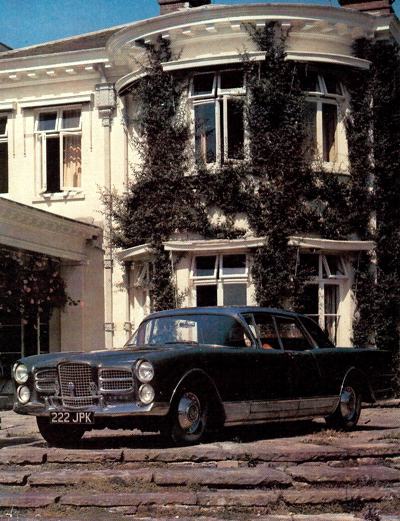 1957 Facel Excellence, which used a pillarless structure for its four-door body, which made the car less rigid than it should have been.
1957 Facel Excellence, which used a pillarless structure for its four-door body, which made the car less rigid than it should have been.
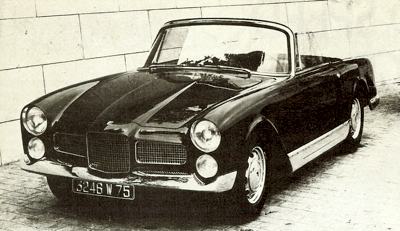 1961 Facellia convertible.
1961 Facellia convertible.
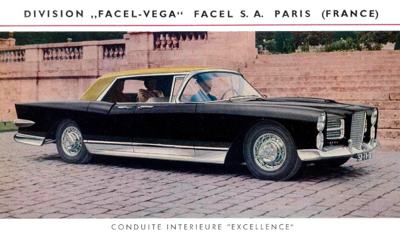 1957 Facel Vega Excellence.
1957 Facel Vega Excellence.
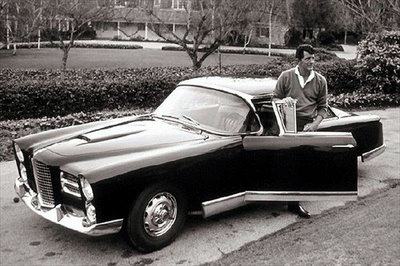 The image of Facel Vega was enhanced by some of its famous owners, such as Ringo Starr, Pablo Picasso, Ava Gardner, Joan Fontaine, Tony Curtis and Dean Martin.
The image of Facel Vega was enhanced by some of its famous owners, such as Ringo Starr, Pablo Picasso, Ava Gardner, Joan Fontaine, Tony Curtis and Dean Martin.
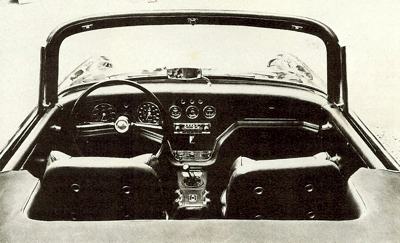 Interior shot of the Facel Vega Facellia.
Interior shot of the Facel Vega Facellia.
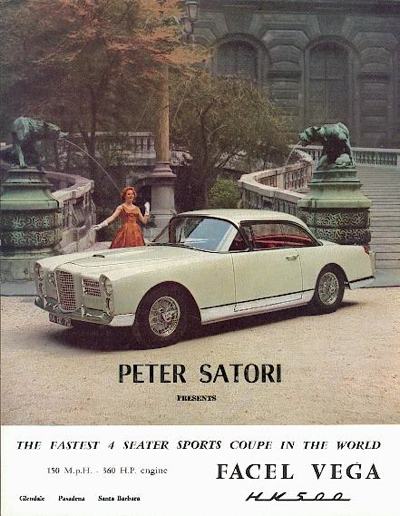 Facel Vega HK500.
Facel Vega HK500. |
The Facel Vega
Mechanically, this two-door coupe featured a ladder-type chassis frame of large-diameter steel tube, stiffened with various cross bracing struts and having built-up superstructures for the rear suspension, scuttle and front suspension. This front suspension was by double wishbones and coil springs, while the live rear axle was supported on semi-elliptic leaf springs. For the power unit, Facel chose the Chrysler 4
½-litre V8, which gave 180 bhp at 4500 rpm, while for transmission there was a choice of the Chrysler Torqueflite three-speed automatic or the four-speed Pont-a-Mousson manual gearbox. Facel were not fully fledged car manufacturers so they had to rely on component makers for many of their parts. The rear axle was a British Salisbury unit, the worm-and-roller
steering was the German Gemmer, the drum
brakes were French-made Lockheed units, the dampers came from Alinquant - and many other manufacturers supplied parts.
In spite of its 'kit of parts' genesis, the car received rave reviews from testers, who naturally found it a good deal faster than many European exotics, although few of the early testers criticised the inadequate
brakes and low-geared
steering of the Facel Vega. Production began in 1955, and exports soon took up a good proportion of Facel sales - although right-hand drive was not available until 1957. The early cars appealed mostly to those who required a fast, silent tourer rather than an out-and-out sports car, as the braking and
handling would not have satisfied the sports-car driver. However, the interior was lavishly equipped and a mass of instruments were set in a walnut-panelled facia.
Electric windows, a good heating and ventilation system, cigarette lighters and ashtrays were fitted as standard items. The problems were gradually ironed out of the chassis, but the makers were always at a disadvantage, in that they relied on the products of other manufacturers. The Detroit horsepower race was just getting under way and engine sizes leaped dramatically, so that, by 1957, the engine size had grown to 5.4 litres and the power output to 250 bhp. This meant that, despite the fitting of a brake servo and improved linings, the
brakes were still inadequate for the power.
The Facel Vega Excellence
However, the suspension was improved and British Hydrosteer power
steering became an optional extra. Roadholding was improved by the adoption of Michelin X tyres. Variations on the basic theme were tried by the factory. A pretty convertible was designed as early as 1955, but only the
prototype was ever built. However, the Excellence, which first appeared in 1957, was produced spasmodically until the firm went out of business. The Excellence was designed as a four-door saloon, necessitating an addition of 1ft 8in to the 8ft 8in wheelbase of the Facel Vega. Unfortunately, it was decided to use the pillarless type of construction for the Excellence, with the result that the body had insufficient rigidity, causing the doors either to jam or to refuse to shut.
Although more strengthening was incorporated, the problem was never overcome and production remained at a very low level. By 1958, right-hand drive was available and George Abecassis of HWM, at Walton-on-Thames, took on the British agency. This immediately increased sales, as Abecassis was a noted racing driver in the UK who also sold other exotic cars, such as Aston Martin, while another British racing driver, Lance Macklin, was employed by Facel in Paris as a salesman and development driver. Between them, these two persuaded
Stirling Moss to buy a Facel in 1959, which again added to the reputation of the company. Later, Moss's entrant, Rob Walker, also bought a Facel Vega, which he used for many of his Continental trips to race meetings for several years, although as a garage owner himself, he had the choice of many other fast and luxurious cars.
The Facel Vega HK500
The 1958 model sold in Britain was the Facel Vega Sport, now with a 325 bhp, 5.8-litre Chrysler 300C engine and capable of a top speed of 130 mph. Drum
brakes were still standard equipment, although Dunlop disc
brakes were an optional extra; they became standard equipment in 1960. In 1960, the big car was renamed the HK500. It incorporated a few styling changes, the introduction of disc
brakes and the use of a 6.2-litre, 360 bhp Chrysler engine. This car was produced in good numbers for several years, and in fact was the most successful of the Facels.
The Facel Vega Facellia
Jean Daninos was intensely patriotic, so he disliked having to use such a large quantity of British and American parts in his car. He also wanted to increase production at the Paris factories, which seldom exceeded twenty a week of the V8 cars, so he took the step of building a small sports car powered by his own engine. The new small car, called the Facellia, was a V8 Facel in miniature, with a body style virtually identical to that of the Facel Il V8, which was to follow at a later date. The chassis was of tubular steel, like that of the big car, with the body welded and bolted to it. Front suspension was by double wishbones, coil springs, telescopic dampers and an
anti-roll bar, while the live rear axle was suspended on semi-elliptic leaf, springs and telescopic dampers, in conjunction with an
anti-roll bar.
Steering was by the same Gemmer worm-and-roller layout, but with only 2.9 turns lock to lock, and braking was by Dunlop discs on all four wheels. The car was powered by a brand new four-cylinder, twin-overhead-camshaft unit of 1646 cc, which developed 115 bhp at 6400 rpm. The engine was made largely by Pont-a-Mousson who also provided the four-speed gearbox. Only a convertible was available initially, but a four-seater coupe was made available in 1961. The car had a tremendous impact in France as it was the first sports car which many people could afford, and many orders were taken during its first show appearance.
But there were one or two unfortunate design faults in the engine's water jacketing, with the result that the pistons tended to burn through very rapidly if the car was held at high speed for any length of time. Most of the early cars were soon back at the factory for expensive engine repairs under warranty and, as word got around, buyers dwindled, although Facel were none too keen to sell the car anyway, since they knew they would have to overhaul engines quite frequently. The problem was overcome by 1962, but customers were naturally wary of the twin-cam unit, while Facel were finding it expensive to make, so they searched around for an alternative, cheaper engine.
The Facel Vega Facel II
They settled on the
1.7-litre Volvo P1800 motor, which. gave 108 bhp at 5500 rpm and fitted the engine bay of the Facellia; it came with the Volvo gearbox and the option of Laycock de Normanville overdrive. This was too late to save the Facellia, although quite a large number were built, and it was dropped in 1963. Meanwhile, the HK500 had given way to the Facel II, a good looking car with sharper, cleaner lines than the rather bulbous HK 500. The chassis was largely unchanged, although British buyers could opt for Armstrong Selectaride adjustable rear dampers. The power unit had now grown to 6.3 litres, with a claimed power output of 390 bhp at 5400 rpm, which would give the car a top speed of 150 mph according to the factory; but the best recorded by Motor in 1963 was 134 mph, although a 0-60 mph time of 5.3 seconds was impressive then.
The Facellia's troublesome birth pangs had brought financial problems to the car-manufacturing division, and in mid 1962 a receiver was appointed to control the company's fortunes. He allowed a new company, called SFERMA, to take over, and they attempted to resuscitate the firm by fitting the Facellia with an Austin-Healey 3000 engine, allegedly in 2.5-litre trim to escape the French high-taxation category. This created no great interest and only a few were ever sold. The Face! Il was still selling quite well, but other makers had caught on to the idea of a big lazy American engine in a European chassis, and Facel customers were now being wooed by firms like Bristol, Gordon-Keeble, Iso, and Jensen.
The Facel Il chassis was no match for most of these and in late 1964 the new management gave up the struggle and allowed the firm to go into liquidation. The Facel Vega faded rapidly from the scene as owners sold examples as quickly as possible. But within a decade of the car's final demise the Facel had suddenly become a classic. And any collectable cars status can be helped by famous owners: Paul McCartney had an Aston Martin, John Lennon a Rolls-Royce, George Harrison an E-Type and ... Ringo Starr a Facel Vega. Other Facel Vega owners include Pablo Picasso, Ava Gardner, Joan Fontaine, Tony Curtis, and several Saudi princes.



